Neither of us had been there before: enticing, but expensive and complicated. This turned out to be our most difficult trip to organize. Susan could find no travel agent or web site to manage it all, so took charge herself. result was an exhilarating but once again somewhat exhausting undertaking.
First flew to Anchorage, via Chicago. The last hour was spectacular, with views of the huge sprawl of Mt. Logan. Highest point in Canada, second-highest in all North America. Looked very snowy and cold from above. An hour later we were at the Ted Stevens International Airport. Alaska has the quaint habit of naming public works after sitting politicians.
Anchorage, population ca. 250,000, is the state’s only real city. (Fairbanks, next largest, has little more than 30,000.) It has arms of the sea to the west and the Chugach Mountains to the east, but the city itself is not very interesting. It is flat and spread out (the city limits make it larger than Delaware). It does have lots of good restaurants and outdoor equipment stores. Our B & B, the Susitna Place, was comfortable and friendly. Its deck has great views. There are only a few signs of the 1964 earthquake. (Susan’s father’s company was involved in redevelopment efforts.)
Next morning we took a train 100 miles north to touristy Talkeetna, starting point for most assaults on Denali (Mt. McKinley). We had no such ambitions--just sight-seeing. On the new $3.4 domed rail cars you view a whole lot of forest and eventually some fine mountains. You also get a free cocktail. (I recommend continuing all the way to Fairbanks, for the very best scenery.) Young high school grads, exclusively female so far as I could tell, compete to serve as guides for two summers. On the way back ours announced, “You guys are lucky you weren’t in Anchorage this morning. The weather was rainy and gross.”
At Talkeetna we boarded a 4-seater Maule float plane for a 13-minute hop to the Caribou Lodge, the only habitation on Boomerang Lake. Our hosts,Mike and Pam Nickols, had refurbished an old hunting camp, where they live year-round and take guests. The year-around part is daunting. Winter snows and temperatures well below zero. They moved there 13 years ago, with their son, whom they home schooled. The first 5 winters they subsisted on pancakes and moose (a single one lasts the season). No road. You either fly out (provided the lake is either free or sturdily frozen) or mush (they have eight huskies). The lodge is popular winter destination for Japanese fascinated by the northern lights. Another visitor was a German butcher who wanted to practice his craft on a moose.
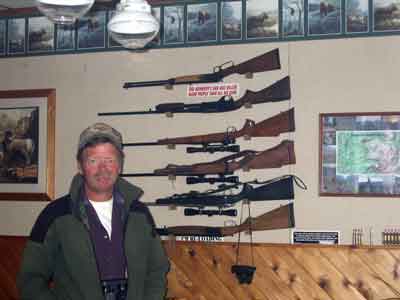
Our first sight inside the camp was a rack of six rifles and a sign: “Ted Kennedy’s car killed more people than all my guns. ” A large selection of Tim LaHaye’s “Left Behind” books sat on the shelves. “Susan,” I said. “Don’t wear your Ho Chi Minh tee-shirt.” Happily, Mike was comfortable with occasionally contentious debate. Pam was a magnificent cook.
We needed no persuading that the rifles (they were loaded) could be useful. Black bears and grizzlies were common. They will usually leave you alone, but don’t surprise them with their kill or get between mother and cubs. Even then, you never know. A few weeks later, in the northern part of the state, a very cautious and knowledgeable couple were killed by a bear at their campsite. (If you need further persuasion, check out the Werner Herzog film, Grizzly Man.) Mike took us on several hikes, accompanied by his rifle and whoever else was in residence. We did see a marmot.
At the top of a small rise behind the cabins is a spectacular view of Denali, weather permitting. It looks enormous, even though it is more than 60 miles away. It is some 3000 feet higher than its only competitor, Mt. Foraker. Although climbed by hundreds every summer (about 50% make the top), it is formidable and dangerous. In May, two climbers died on the West Buttress, the most popular route. Although modest in height by Himalayan standards, it is very far north and therefore extremely chilly. My Italian guide in the Dolomites, who had been to 8000 meters on K2, said McKinley was the coldest place he had ever been.
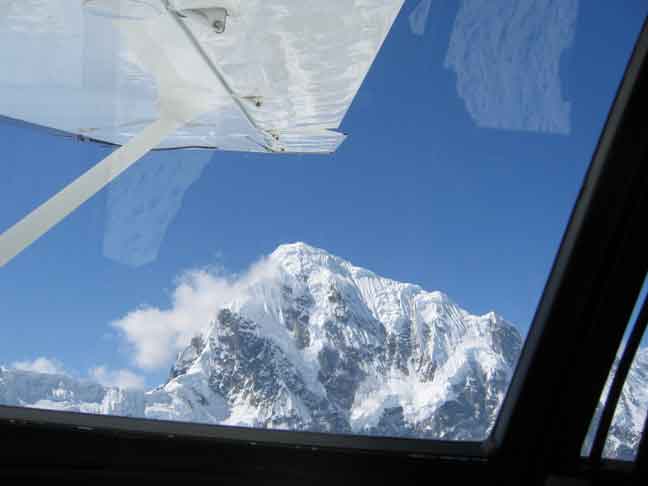
In order to have a closer look, Susan and I did a bit of what is rather horribly called “flight-seeing.” A float plane took us to about 8000 feet, still a long way below the top of Denali. The lesser peaks were more immediate and striking, particularly the scary Mt. Huntington, which was not climbed until 1964. We then turned down the Ruth Gorge, site of many hard rock climbs in recent years. No climbers were visible.
Back in Anchorage, we assembled for our first-ever Sierra Club trip. We were a total of 17. Demographic ranges:
Age: 10 to 86 (some deception was involved at the high end);
Gender: male to female;
Sexual orientation: gay to straight.
We were families, parts of families, and singles. Two of the singles almost immediately became a double.
We traveled in two Chevy Sport Vans, the blue van and the tan van. The latter was known, at least to us, as the Jewish van, because of its 8 passengers (we had not divided by design). The driver, one of our leaders, was the token Gentile. We drove first to the tiny town of Whittier, on the west end of Prince William Sound. It was this part of the sound that was famously fouled by the Exxon Valdez oil spill of 1989. The water again looks pristine, but we were told that many traces of the disaster remain. From Whittier we took the first of many ferry trips. The boats are very comfortable, but operate on an inconvenient schedule. We made our destination, Cordova, after midnight, and sought a camping place. Most of Alaska is light all night this time of year, but a drizzly overcast dampened our spirits. The campground made things worse--pure unyielding gravel. Nevertheless we raised our brand new Hard Wear tent and slept fine for what remained of the night.
Here is the drill: ten nights, eight of them in campgrounds, two in motels or lodges. All food was carried in the vans. It was very planned and tasty. Cooks were a different three every 24 hours. A three-burner Coleman stove was more than adequate. Evenings were spent conversing around the camp fire and occasionally indulging in somemores (shmoors). All food was stored overnight in bear-proof lock-ups. After the first, the campgrounds ranged from acceptable to very pleasant. The best was at Childs Glacier. The glacier itself terminated only a few hundred yards away, where it calves into the Copper River. One summer such a large piece came off that its waves injured a woman on the far shore. Watching the glacier was literally cool, and also bug-free. (We were plagued by mosquitoes much of the trip. Head nets were very useful.) Like most Alaska glaciers, this one is in retreat. With a few years it may end short of the river and leave an ugly moraine.
In keeping with the moderate character of the trip, the group (most of it) took a brief afternoon hike. Very lovely forest, but we were disconcerted by a sign warning of a “very aggressive bear” in the vicinity. We did not see it--nor indeed, any bears the entire time--to our disappointment and relief.
We drove to Cordova, a place you cannot drive out of. Bumper stickers proclaim:
no road
Cordova Alaska
in an effort to discourage road links to the rest of the state. Access is by air or water only. Now that we were back on Prince William Sound, we went sea kayaking in Orca Bay. Our guide was a young woman improbably named Seawar (that’s Algonquin for “seashell”). Susan was in front, I in back, which meant I had to steer. I had never used kayak rudders and found them tricky. But the waters were calm and the snow-and-forest scenery was incomparable. Eagles abounded.
This was our night in the motel--we had to be up at 4:30 for another inconvenient ferry. Our room was generic, its only Alaskan feature a wall notice: “Many of you will be catching fish to take home with you. We request that you use our special ‘fish towels’ to use instead of your bath and hand towels.”
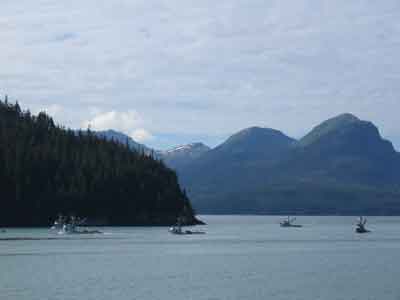
The morning ferry brought us past the site of the oil spill to Valdez itself. The town was entirely relocated after the huge earthquake of 1964, which also did a job on Anchorage and a lot of other places. A museum shows video clips of this cataclysm. Our vans then north and east on a long, dusty drive to a campground in the Wrangell-St. Elias National Park. The park is bigger than Switzerland. We spent five nights here, four of them in the campground. The other night, the group was in the Kennicott Glacier Lodge, a sprawling building with great views. It did not have space for us all, so Susan, I and The Double stayed five miles down, in wild west viewless McCarthy. Ma Johnson’s Motel, built by Ma and her husband in 1921. It’s comfortable, if you don’t mind small rooms and shared bathrooms, but the raucous street life makes sleeping difficult. It doesn’t quiet down at sunset, because the sun never really sets. At least the bar across the street bans weapons, “including 3-inch knives.”
From McCarthy a dirt road ascends 5 miles to the old Kennecott [correct spelling] mines, once lucrative, now abandoned. You can walk or take a $5.00 shuttle that runs on a sometimes-followed schedule. You will pass a few habitations, and signs: “Chicken Crossing”; “Several Stupid Dogs Live Here.” Activities in the area included a walk on the Root Glacier. Crampons yes, ropes, no. All the crevasses are exposed--you can jump in but not fall in. There’s a great view of the snowy expanse of 16,000-foot Mt. Blackburn. Apparently, though it’s hard to believe, it has never been summitted from this side. We also hiked, making lots of noise to alienate the bears, and took a moderate rafting trip.
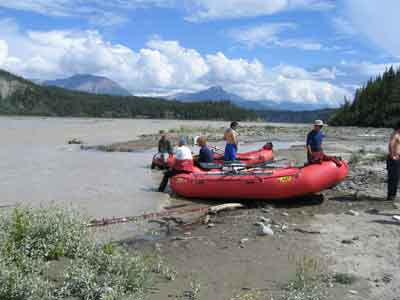
Back in Anchorage, we missed the group celebratory diner because we had a flight north to Fairbanks. The plane was delayed, but it is never really late in summertime Alaska. We arrived at the Ah, Rose Marie B & B after 8:00 and strolled out for a Mexican dinner. After an early (excellent) breakfast the next morning we took a taxi to a small airport for our next destination: the tiny settlement of Bettles, north of the Arctic Circle. The air terminal, such as it was, was empty and locked. After a while our fellow passengers arrived: an eleven-year-old girl from Park Slope (Brooklyn) and her two mothers. When the pilot showed up, he promptly vanished to pick up some tomatoes. Reminded us of Mongolia. Eventually we got to Bettles, a hard-scrabble little place. It has cars, but nowhere much to drive to. There’s not a great deal to do there, though it is a great flying-off place for points even farther north. The lodge proprietor took us on a motorboat trip down the river. She had trouble starting the motor; and after she did, she grounded the boat on a gravelly ledge. We got out and pushed. Later we landed for a brief hike, with the worst mosquitoes yet. We had a close look at the effects of global warming--tracts where the perma-frost had recently melted.
Our most exciting time out of Bettles was a float plane to the Arrigetch Mountains in the Gates of the Arctic National Park. Spectacular doesn’t begin to describe it. Climbers and other inquisitive folk: check out www.stanford.edu/~clint/arrig/
From the air the peak look utterly holdless, but many have routes of only moderate difficulty. The myth is that the raven created the world with gloves on his claws, but removed them when he made the Arrigetch (“finger” or “talons”).
We had most of a day back in Fairbanks. A chalked notice informed us that daylight had dwindled to 21 hours and 7 minutes. Taxis were so expensive that we rented a car, which we drove to the University. It has a magnificent hillside location and a fine museum, which is being expanded. We did wonder how students got from one building to another in winter temperatures, which commonly reach 30 below.
Continuing south, we flew to Juneau--the only state capital not reachable by road. Efforts to move it are regularly defeated. It is a beautiful place, on the east side of the Gastineau Channel and framed by forested mountains. We stayed at the Alaska Wolf House, a B & B more than a mile north of town. We arrived late. Our host, Jeff, who is a chef among other things, produced (without charge) a plate of smoked salmon on crackers. Delicious. So were his breakfasts, which included highly sophisticated blueberry pancakes. Nevertheless we felt uncomfortable at the Wolf House. Its literature pointed out that it wasn’t a hotel, but “our home.” (Jeff is married with an infant daughter, whom we scarcely heard and never saw. There is also a very Great Dane.) The rooms were downstairs. The living room clearly was off-limits after breakfast. Our last day there, we had to leave our baggage on the porch until evening departure, no other space being offered.
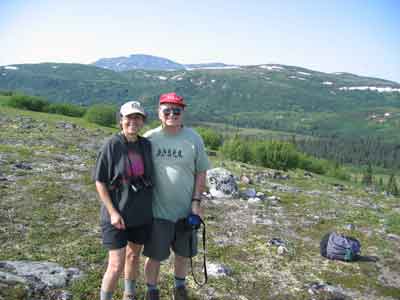
We do have to thank Jeff for a loan of pepper spray to fend off bears (it works only when they get quite close). We carried it on a steep hike through a hemlock forest and thence to a barren ridge. Although never above 4000 feet, we encountered late-season snow patches. Also clouds and wind, which promoted a retreat. The views, when we had them, were gorgeous. The Gastineau Channel was dotted with boats and float planes. It also provided berth for a number of cruise ships. These monsters look like whitened, slightly shabby 12-story apartment buildings, except that they are longer, and they float. The largest can take 2600 clients. These passengers are disgorged upon the small towns, where they flood the shops and streets in search of authentic memorabilia. Unfortunately, many shops are owned by the cruise lines, not by the locals.
One way to avoid cruise ships yet sail the inland passage is to take a ferry, which is also a lot cheaper. This we recommend, despite the following: the boat coming south from Skagway was due in Juneau at 9:30 p.m. We arrived in good time to find the terminal locked up and no ferry in sight. A dozen other hopeful passengers were as clueless as we. The phone recording insisted that the ferry was on time; no sign to the contrary was posted. An engineer who had been flown up from Seattle to service the ship left a vituperative message on the ferry company’s answering machine and went back to his motel.
The boat showed up about midnight, and we boarded an hour later. But because of complicated tidal considerations we could not depart until 5:30 a.m. We did get a good rest in our cabin, which was appreciable roomier than the closet-like space we occupied some years ago off Norway. The scenery was marvelous.
The invariably inconvenient schedule brought us at midnight to Ketchikan, where we stayed at the oddly named New York Hotel. We were now far enough south that it was actually dark. It rains here about 90% of the time, but we hit the 10%. This permitted a pleasant hike up Deer Mountain.
One last ferry trip took us across the border to Prince Rupert, British Columbia. The town has not many activities, but it does have the agreeable atmosphere of a small Canadian port. In the afternoon we took a bus to the airport; it is oddly situated on an island, which is reached by a very brief ferry ride.
Final stop, Vancouver. We once again stayed with our old friends, Mike and Ruth Wortis. I had the added pleasure of catching up with my old climbing and tennis companion, Nick Pott. The Wortis house, which I had last seen in winter, commands an astonishing view over the Burrard Inlet to the snow mountains beyond. Nick and the Wortises are fit and adventurous. We had prudently declined their invitation to a multi-week sea kayaking and camping undertaking, but did the join them for a day of same. Highly gorgeous and just a few miles from home. The next day we all hiked up the steep back trail of Squamish Chief. (The front is a forbidding black cliff favored by rock climbers.) Susan and I were amazed that we had managed this trail a few years back, on New Year’s Day, right after flying from New York. It’s easier in summer, but still a challenge, with guard chains on the steepest sections. We rewarded ourselves at a Vancouver ice cream emporium. 208 flavors, including Durian, Walnut Halva, and Garlic.
Final compatibility note: in an Anchorage shop we were quarreling over something. A young woman, overhearing us, remarked: “You must have been married a long time. You sound just like my parents.”